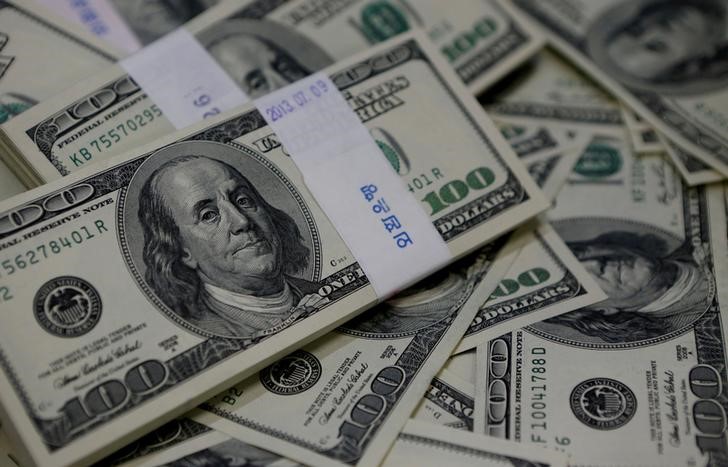
By Lucia Mutikani
WASHINGTON (Reuters) – U.S. job growth surged in February, recording its biggest increase in more than 1-1/2 years, but a slowdown in wage gains pointed to only a gradual increase in inflation this year.
Nonfarm payrolls jumped by 313,000 jobs last month, boosted by the largest rise in construction jobs since 2007, the Labor Department said on Friday. The payrolls gain was the biggest since July 2016 and triple the roughly 100,000 jobs the economy needs to create each month to keep up with growth in the working-age population.
The labor market is benefiting from strong domestic demand, an improvement in global growth as well as robust U.S. business sentiment following the Trump administration’s $1.5 trillion income tax cut package that come into effect in January.
Average hourly earnings edged up four cents, or 0.1 percent, to $26.75 in February, a slowdown from the 0.3 percent rise in January. That lowered the year-on-year increase in average hourly earnings to 2.6 percent from 2.8 percent in January.
The unemployment rate was unchanged at a 17-year low of 4.1 percent in February for a fifth straight month as 806,000 people entered the labor force in a sign of confidence in the job market. The average workweek rebounded to 34.5 hours after falling to 34.4 hours in January.
With Federal Reserve officials considering the labor market to be near or a little beyond full employment, the moderation in wage growth last month did little to change the view that the U.S. central bank will raise interest rates at its March 20-21 policy meeting.
Slow wage growth, however, could temper expectations the Fed will raise its rate forecast to four hikes this year from three. There is optimism that tightening labor market conditions will spur faster wage growth this year and pull inflation toward the Fed’s 2 percent target.
“While the employment gains unequivocally suggest underlying strength in the economy, wage gains remain muted enough for the Fed to continue with an only gradual normalization of the policy stance. Stock markets are reacting accordingly,” said Harm Bandholz, chief U.S. economist at UniCredit Bank in New York.
Speculation that the central bank would upgrade its rate projections was stoked by Fed Chairman Jerome Powell when he told lawmakers last week that “my personal outlook for the economy has strengthened since December.”
While Powell said there was no evidence of the economy overheating, he added “the thing we don’t want to have happen is to get behind the curve.”
Economists polled by Reuters had forecast payrolls rising by 200,000 jobs last month and the unemployment rate falling to 4.0 percent. Average hourly earnings had been expected to increase 0.2 percent in February.
Data for December and January was revised to show the economy adding 54,000 more jobs than previously reported.
U.S. stock indexes opened higher after the data while prices of U.S. Treasuries were trading lower. The dollar was largely unchanged against a basket of currencies.
CONSTRUCTION SHINES
Some companies like Starbucks Corp and FedEx Corp have said they would use some of their windfall from a tax cut package to boost workers’ salaries. Walmart announced an increase in entry-level wages for hourly employees at its U.S. stores effective in February.
The employment report suggested the economy remained strong despite weak consumer spending, home sales, industrial production and a wider trade deficit in January that prompted economists to lower their first-quarter growth estimates. Gross domestic product estimates for the January-March quarter are around a 2 percent annualized growth rate. The economy grew at a 2.5 percent pace in the fourth quarter.
The full impact of the tax cuts and a planned increase in government spending has yet to be felt, and a robust job market could heighten fears of the economy overheating.
“The economy is simply too strong,” said Chris Rupkey, chief economist at MUFG in New York. “There’s no reason whatsoever for the Federal Reserve to have a stimulative monetary policy at this stage of the business cycle.”
Economists expect the unemployment rate to fall to 3.5 percent this year. A broader measure of unemployment, which includes people who want to work but have given up searching and those working part-time because they cannot find full-time employment, was unchanged at 8.2 percent last month.
The labor force participation rate, or the proportion of working-age Americans who have a job or are looking for one, rose three-tenths of a percentage point to a five-month high of 63.0 percent in February.
An even broader gauge of labor market health, the percentage of working-age Americans with a job, increased to 60.4 percent last month from 60.1 percent in January.
Employment gains were led by the construction sector, which added 61,000 jobs, the most since March 2007. Hiring at construction sites was likely boosted by unseasonably mild temperatures in February.
Manufacturing payrolls increased by 31,000 jobs, rising for a seventh straight month. The sector is being supported by strong domestic and international demand as well as a weaker dollar. Retail payrolls jumped by 50,300, the largest increase since February 2016.
The Labor Department said that was because on an unadjusted basis the sector hired fewer workers than usual for the holiday season and did not shed many jobs after the holidays. As a result, retail employment rose after the seasonal adjustment, the department said.
Government employment increased by 26,000 jobs last month, with hiring of teachers by local governments accounting for the bulk of the rise. There were also increases in payrolls for professional and business services, leisure and hospitality as well as healthcare and social assistance.
Financial sector payrolls increased by 28,000 last month, the most since October 2005.
(Reporting by Lucia Mutikani; Editing by Andrea Ricci and Paul Simao)










